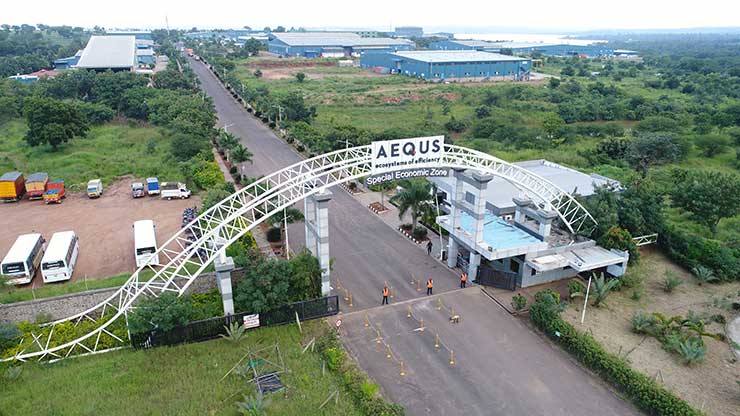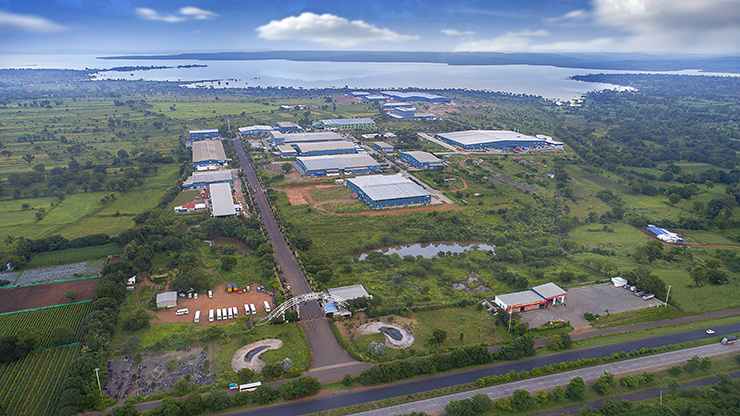Aequs, a diversified contract manufacturing company, has undergone remarkable transformations since its inception in 2006-2007. Initially established as QuEST Global Manufacturing, a division of Quest Global in Bengaluru, Aequs has grown from a contract manufacturer into a comprehensive and fully equipped company with an ecosystem specifically designed to meet the aerospace industry’s rigorous demands. This evolution includes the capability to manufacture complex aero parts.
In an exclusive interview with Raksha Anirveda, Aravind Melligeri, Chairman & CEO of Aequs delves into the strategic decisions that have shaped the company’s journey, the challenges overcome along the way, and the significant impact Aequs has had on the aerospace sector as well as on the local communities. Melligeri provides insights into how choosing Belagavi as a base has been instrumental in building a unique aerospace ecosystem, highlighting the incremental successes and community engagements that have defined Aequs’ growth trajectory. Excerpts…
RA. How has been the journey of Aequs so far? Were there challenges to overcome?
AM. It all depends on how you define the journey. I believe all successes are incremental in nature, and this has certainly been the case with Aequs. Since its establishment in 2006 as the fledgling QuEST Global Manufacturing in Bengaluru, it has successfully weathered numerous challenges, steadily accumulating capabilities, scale, and skills along the way. One of the high points in this journey was the establishment of the Aequs Special Economic Zone (SEZ) in Belagavi. This SEZ was recognised as India’s first notified precision SEZ dedicated to aerospace components. The initial unit in this SEZ, Aerospace Processing India Pvt Ltd, was set up in collaboration with Magellan Aerospace, a multinational surface treatment giant. Over time, Aequs has expanded this to include thirty-one other units, creating a unique aerospace ecosystem unparalleled in the region, and perhaps even globally.
“All successes are incremental in nature, and this has certainly been the case with Aequs. Since its establishment in 2006, it has successfully weathered numerous challenges, steadily accumulating capabilities, scale, and skills along the way”
Choosing Belagavi as the location for the Aequs SEZ, despite its distance from Bengaluru, was a counterintuitive decision that raised many questions. However, we were clear about our requirements: the availability of engineering talent, proximity to logistics hubs, and the availability of land. When viewed from a global perspective, the decision was not difficult. The global aerospace supply chain is distributed across the world, with major Original Equipment Manufacturers (OEMs) often locating their operations in hinterlands. Once our customers see our capabilities and infrastructure, they are eager to engage with us. Ultimately, what they need is quality execution on time, every time, and we have consistently met this requirement over the years.

RA. As a brand, Aequs (Latin for equal, suggesting a partnership between equals) focuses on creating ecosystems of efficiency through equitable partnerships. How has this brand philosophy driven the company’s growth trajectory and helped its positioning amidst intense competition?
AM. You are right. Our focus has been on creating ecosystems of efficiency, a term that is incidentally a registered trademark of Aequs. An ecosystem in this context is a conglomeration of everything that goes into a successful manufacturing operation. We envision it as a network of people, manufacturers, tertiary services, and necessary capabilities, all within close proximity, preferably within the same campus. To that extent, Aequs’ Belagavi Aerospace Cluster (BAC) meets all these requirements. This approach has driven all our activities, including the partnerships we seek, which have been central to building, nurturing, and growing this ecosystem.
“Choosing Belagavi as the location for the Aequs SEZ was a counterintuitive decision that raised many questions. However, with its engineering talent, proximity to logistics hubs, and availability of land, the choice proved advantageous for developing a unique aerospace ecosystem”
This philosophy has not only facilitated our growth as a manufacturing entity and as a community of manufacturers but has also positively impacted the lives of the communities around our ecosystems. Our community engagement occurs both organically and inorganically. For instance, most of the employees at our Belagavi campus, which also includes two consumer products units, come from 60 villages around the cluster. They commute daily, and over the years, we have seen a visible improvement in their lives – a testament to our contribution to the immediate community. Additionally, through the Aequs Foundation, we engage with the extended community, conducting programs in safety, health & hygiene, and STEM (Science, Technology, Engineering, and Mathematics) education for students in government schools around our campuses. To date, the Foundation has positively impacted the lives of over 30,000 students.
RA. How has the establishment of the precision engineering and manufacturing SEZ in Belagavi, the country’s first notified SEZ in the private sector, benefited Aequs in expanding its business and global footprint? Have you been able to optimise the SEZ capacity to the fullest, and do you plan to replicate the SEZ model elsewhere in the country?
AM. As mentioned earlier, setting up the Aequs SEZ in Belagavi was a deliberate and well-thought-out move in 2009, at a time when all attention was focused on tier-1 cities like Bengaluru. However, it was not an exceedingly difficult decision. Belagavi’s proximity to Pune and its automotive industry meant that elements of the ecosystem, such as casting, forging, and engineering capabilities, were already in place. Additionally, from a logistics perspective, Belagavi’s proximity to trade hubs like Mumbai and Bengaluru was advantageous. The region also boasted an abundance of engineering colleges, providing a critical talent pipeline for high-precision manufacturing operations.
The ecosystem approach has been crucial for our growth and the expansion of Aequs’ footprint. With the success of our aerospace operations in Belagavi, it was only a matter of time before we needed to get closer to our customers in Europe and the USA, prompting us to establish aerospace manufacturing operations on both continents. Manufacturing capacities are a function of business and customer demand, and we have been both optimizing and expanding as necessary. The Belagavi SEZ provided a template for larger sector-oriented manufacturing hubs, leading us to establish two more clusters in North Karnataka. Our engineering prowess and machining capacity have also recently enabled us to foray into precision machining for the fast-growing consumer electronics industry.
“Our community engagement happens both organically and inorganically. Most of the employees at our Belagavi campus hail from 60 villages around the cluster. Over the years, we have seen a visible improvement in their lives, a testament to our contribution to the immediate community”
RA. The long-term outlook for the Indian aerospace sector appears promising despite many challenges. As a component manufacturer and part of this vast ecosystem, do you think India is well-positioned to engage in commercial aircraft manufacturing, or must it wait for now? Kindly elaborate with your insights.
AM. The Indian aerospace sector has indeed reached a stage where it can absolutely start preparing for its own end-to-end civil aircraft manufacturing ecosystem. Recent discourse, including government initiatives, has focused on encouraging OEMs to set up full assembly lines (FALs) in India. This is crucial for two main reasons. First, India is currently the biggest market for commercial aircraft in the world. With its huge demand for airplanes, India is expected to become the centre of the world aviation industry over the next decade, with around two thousand new planes on order until 2025. Second, the Indian supply chain has matured enough to aspire to full-fledged aircraft assembly. However, I would caution that this is at least a 10 to 15-year journey. There are still many missing elements in our domestic manufacturing capabilities that need to be developed. Encouraging OEMs to set up FALs here will surely help build these capabilities and mature the ecosystem in the country.

RA. Do you think policymakers have given adequate attention to aerospace component manufacturing, a critical area for India’s emergence as a global supply chain hub? Please share your viewpoint and suggestions, highlighting specific areas that require focus.
AM. There is much to be desired when it comes to policies for aerospace component manufacturing in India. Currently, there is no comprehensive national aerospace policy. While individual states have their own policies, and there are policies for different segments of the sector like the Civil Aviation Policy, the Maintenance, Repair, and Overhaul (MRO) Policy, and the Drone Policy, there is no overarching National Aerospace Policy that addresses the issues of the aerospace supply chain comprehensively.
“India’s aerospace sector has reached a stage where it can start preparing for its own end-to-end civil aircraft manufacturing ecosystem. However, it is a 10 to 15-year journey, requiring the development of many missing elements in our domestic manufacturing capabilities”
If the dream of a Made in India passenger aircraft is to be realised, we need a comprehensive National Aerospace Policy that propels the local aerospace ecosystem to maturity. India needs to transition to a ‘design and build’ model, which is a lengthy and risky process. Indian aerospace supply chain companies tend to invest capital in short-term, minimal risk opportunities. To mature along the value chain, they need to invest for the long term. Policymakers must address these issues, create incentives for long-term investment, and provide a clear roadmap for the industry’s growth and development. This will help build a robust and self-sustaining aerospace ecosystem capable of meeting global standards.





